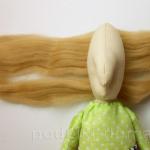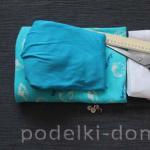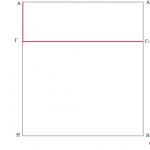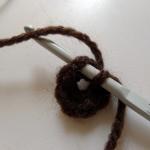How to iron velor items. Principles of washing velvet items, removing stains, drying, ironing How to iron a velvet dress
Velor is a general name for a number of materials with a soft, velvety pile surface. These include some woolen and knitted fabrics, certain varieties of velvet and plush.
This soft, delicate, durable and wear-resistant material requires special care. Products made from it are recommended to be washed by hand or on a delicate cycle at temperatures up to 30°C without using aggressive detergents. detergents; You can't unscrew them. Employees of the SkladokNet online store will tell you in detail how to properly iron velor items.
To care for velor products, you need a professional steamer or iron with several temperature settings and a steam function. A modern heated surface would be a good idea: it will help quickly remove wrinkles from a delicate item without damaging it. If you don’t have an iron with a steam generator function, you can iron the product with a conventional device through several layers of wet gauze.
Before ironing velor items, pay attention to the following rules:
- hang clothes carefully after washing. The more it wrinkles, the more time and effort it will require to care for;
- Velor is ironed only from the wrong side, so as not to wrinkle the pile. As additional insurance, you can put terry towel;
- When ironing, the sole should not be pressed close to the surface - it is better to steam the item at a short distance;
- deep folds can be sprinkled with water from the inside;
- It is necessary to smooth things along the fibers so that the fabric does not deform;
- When processing with an iron or steamer, it is recommended to choose a temperature of no more than 100°C.
After treatment, it is better to leave the clothes for 10-20 minutes. in a neatly hung state, otherwise the heated fabric can easily become deformed.
How to iron a velor dress?
The dress is ironed starting from the top: sleeves, shoulders, collar, neckline, bodice; then the lining and skirt. Lastly, decorative elements are processed: bows, frills, lace.
When using a steamer, you need to start with large parts - the skirt and bodice. After them, the sleeves, collar, and decorative elements are smoothed.
How to iron a velor jacket?
Blazers and cardigans are ironed in the following order: pockets, sleeves, shoulders, front, hem, back; last but not least, the lapels and collar. Small items can be easily handled using the narrow front part of the iron. To iron your sleeves well, you can use a special shelf that comes with most ironing boards.
How to iron a velor coat?
The product should be ironed slightly damp. First, smooth out the lining, then the seams, sleeves, back, lapels, front panels, collar, shoulders. At the end, go through the seams again with the tip of the iron.
How to iron a velor skirt?
Skirts are ironed starting from the top: waistband and pockets. After this, the seams, zipper, main part and bottom are processed. If the skirt is decorated with pleating, the folds can be ironed one at a time or secured with threads.
When steaming clothes, make vertical movements along the fibers. Do not bring the iron too close to the surface: this may damage the pile. Smooth out large elements first, small ones last.
High-quality steam ironing equipment for clothing care (irons, steamers, steam generators, ironing boards and entire systems), as well as useful accessories (attachments, mats, covers and much more) can be purchased profitably in the SkladokNet online store. Several types of delivery, a guarantee, assistance in choosing – these are just some of our advantages. Contact us!
Soft, flexible... it's all about velvet. What is not sewn from velvet fabric - jackets, jackets, skirts, bags, caps and even household items - tablecloths, curtains, bedspreads, pillows, napkins... Things made of velvet are timeless classics, therefore they always remain at the peak of popularity in any fashion season.
However, many people refuse to buy and sew things made of velvet because they do not know how to properly care for them. Velvet is a rather capricious fabric. Creases, folds... It is not always possible to smooth out velvet with just an iron. To do this you need to know a few tricks.
How to iron velvet correctly
- In order to smooth out wrinkles on velvet, you need to make a so-called “compress”. On a large table, lay out a blanket folded in several layers, cover with a cotton sheet soaked in hot water. The sheets must be straightened very carefully so that there are no folds or wrinkles. The velvet is pinned at equal distances, first along the length, then along the width. Cover the top of the velvet fabric with a dry and then a wet sheet. Leave this “compress” overnight - in the morning the fabric will be perfectly ironed. In this way you can iron not only new fabric, but also a worn velvet item. Carefully rip the item apart along the seams with sharp scissors and remove the threads. Wash the velvet pieces in a universal solution. washing powder. Velvet fabric should not be squeezed, rubbed too hard, or twisted - rinse several times. clean water and hang over the bathtub to drain. As soon as the water has drained, apply a “compress” to the opened parts, excluding wet sheets. When the velvet fabric pieces are dry, they can be cut again to sew a new item.
- While you are sewing velvet items, store the velvet in a suspended state, otherwise creases and wrinkles may form that are difficult to smooth out.
- There is another way to smooth velvet fabric. Soak a piece of foam rubber in hot water and wring it out well. Cover with a cotton napkin. Heat the iron as high as possible and place it on the foam for a minute. As soon as hot steam begins to rise, remove the iron and immediately place the velvet piece on the foam rubber. Repeat the procedure until you have ironed out all the folds. As you can see, the iron does not seem to be involved in ironing. The foam rubber and napkin have to be wetted several times. Hands must be wiped dry, otherwise marks may remain on the velvet.
As you can see, ironing velvet is not that difficult if you know a few secrets.
The birthplace of velvet is Italy. In the 13th century, when velvet first came into fashion, it was extremely expensive and only the elite of society could afford it. Since then, velvet has been considered a royal fabric. To this day, the most valuable velvet is considered to be a fabric made only from silk threads. In the 20th century Velvet rose to the top of fashion thanks to the famous group The Beatles - coats, hats, dresses, bags - everything was made of velvet. Photo: Peony Lim, Reformation
What is velvet?
Velvet is a fabric with dense standing pile 2-3 mm high. There are many varieties of velvet, for example, wool velor (with a rough pile surface on both sides), panvelvet ( thin cloth with a shiny surface), boiled velvet (short pile soft ribbed velvet that can be washed and ironed).
How to decate
As a rule, velvet is not decatted, since when ironing the pile will become wrinkled, ruining the fabric. But what if the velvet base contains cotton and viscose, which cause severe shrinkage? In these cases, you can use the following method: add hot water, and a piece of velvet is hung over the bathtub. Ideally, you should leave the cloth in this position overnight with the door tightly closed. Thus, the cut is “steamed” and shrinks. There is another way: the velvet is folded in half with the front side inward, after which it is quickly ironed with steam without pressing from the wrong side. Be sure to test this method in advance on a small piece of fabric.
How to cut
Since velvet has a pile, it is extremely important to cut out all the cut pieces with the same direction of the pile. Determining its direction is not difficult: run your palm along the front side in the longitudinal direction and back, the pile will smooth out or, conversely, rise. Accordingly, everything paper patterns laid out on velvet in one direction: either along the pile or against it. Important: on high-pile velvet, the patterns are laid out only against the direction of the pile. This means that on the finished product the pile will be directed from bottom to top. Pan velvet is cut only in the direction of the pile. Before cutting, you can use arrows to indicate the direction of the pile on the reverse side. If the velvet is thick, then it is advisable to cut out the parts in one layer, since the fabric may move due to the pile. Or chop off the parts with needles and cut them in two layers. For duplicating velvet, the adhesive interlining G 785 is ideal: it is ironed dry and with light pressure in the “silk” mode.  Photo: OnceWed, Helvetika
Photo: OnceWed, Helvetika
How to sew
Cutting details made of velvet are stitched with thin sewing threads and a thin needle No. 70 or 80, and pan velvet on a knitted base is sewn with a knitwear needle. The stitch length is approx. 2.5 mm. When sewing with the right sides together, the cut pieces easily shift, so they must be pinned perpendicular to the seam line or basted on both sides of the seam by hand using small stitches. Before sewing the buttonholes, a piece of organza is placed on the part and under it, which is tacked into the seam, and when the work is finished, it is carefully cut off close to the stitching. The lines should be laid the first time and accurately - velvet will not forgive ripping, repeated basting, or newly laid lines. All this will hopelessly ruin the fabric. Remove the basting immediately, as otherwise the threads may leave creases.
How to care
Products made from cotton and synthetic velvet can be washed by first turning them inside out. It is better to dry clean viscose and silk velvet. Wrap a piece of velvet intended for long-term storage around a thick cardboard tube. When packing velvet clothes in a suitcase, roll them up with tissue paper, then you will avoid creases. If it becomes necessary to iron velvet, use only steam and never touch the fabric with the iron. It is best to cover the surface of the board with a thick, nap fabric such as heavy corduroy, mohair upholstery fabric, frieze, or even a thick terry towel.  Photo: Alasdair, pinterest.com
Photo: Alasdair, pinterest.com
Unusual velvet
Bi-elastic panvelvet The technique of working with elastic panne velvet has some peculiarities. The markings are transferred using a plastic copy wheel with blunt teeth or using a knitting needle. A thin knitting needle with a round tip is inserted into the sewing machine, which does not damage the threads of the fabric. Cutting details made of bi-elastic panvelvet are sewn with a special elastic stitch or a narrow zigzag stitch (stitch width 0.5-1 mm, length 3 mm). Advice: make sure that the thread tension is within sewing machine wasn't too strong. Baste and grind the cut details only with thin needles and thin threads. The details of the cut must be pinned together, as pan velvet easily moves when stitched. They sew panne velvet over tailor's pins, pinned perpendicular to the seam line. You can also place parallel seams using running stitches on either side of the seam line and stitch between them. Darts should be sewn and stitched on bi-elastic pane velvet in only one direction. It is best to overcast cuts using an overlocker. You can also overcast the sections with a zigzag stitch using large stitches (ideally a zigzag for quilting). To prevent the sections from rolling up and stretching, the stitching is laid at a distance of 2 mm.
Can everything be called velvet, what seems to them?
Of course no. There is even “fake” velvet. For example, duvetine- fabric of reinforced satin weave, reminiscent of satin, with thickened weft threads, made of cotton or viscose. After dyeing, duvetin is heat treated, combed and smoothed. Chenille also looks like velvet - a heavy fabric with pile on both sides. Plush: fabric with long pile on the front side. The base of the plush is usually made from cotton fabric. The pile can be either cotton, silk or wool. Velveteen- fabric based on cotton and viscose silk, very durable, with different pile heights on the front side. Corduroy has the most different types: velvety corduroy (reminiscent of velvet), corduroy (with a wide rib and high pile), corduroy ribbed (with narrow ribs and low pile), shaped corduroy (with a pattern of alternating smooth and brushed surfaces), elastic corduroy, corduroy with ornament, cotton corduroy, etc.
Ask any girl what kind of fabric she likes - natural or synthetic - she will answer - only natural! There is nothing surprising here - such material allows air to pass through, allowing the body to breathe, it does not cause allergies, it is more pleasant to the body... There are many advantages. But there is one drawback - some natural fabrics need very delicate washing and ironing. Let's look at how to iron them correctly so as not to damage the material. We will tell you about linen, corduroy, suede and other natural fabrics.
Read in this article:
- How should you iron corduroy?
- Tips for ironing linen
- Ironing velor and velvet
- Returning the atlas to its original condition
- Removing wrinkles from suede and satin
Ironing corduroy - what do housewives need to know?
Before we tell you how to iron corduroy, you need to get acquainted with several nuances of this material. They will help you avoid many mistakes when working.
Important Tips:

And now it’s time to tell you how you can smooth out creases on corduroy fabric. Set the temperature to position “2”, place a soft substrate under the fabric - for example, a thin blanket folded several times does this job perfectly. Proceed with ironing, being careful not to press too hard on the device, otherwise after ironing you may find shiny spots on the material.
If you don’t have an ironing board at hand, use a thick, large pillow, cover it with a clean cloth - place the clothes that need ironing on top, cover with gauze and get to work, almost without touching the corduroy. By the way, some housewives manage to iron such delicate fabric by weight - they place and secure the iron with the sole up and simply carry the fabric over it. Such a gentle treatment will remove light creases, and there will be no marks or stains left on the material.
How to iron? Read us!
To iron synthetic fabrics, you don’t have to take things to the dry cleaner, where they will be restored to their former appearance. We have collected for you all the tips on ironing fabrics such as neoprene, dermantin and many others! Read our article and get started!
In general, ironing things still, despite the abundance of special equipment, raises a lot of questions for many housewives. We've answered them here - you just have to read our recommendations and you can start ironing.
How to smooth linen or how to iron such a stubborn material?
Linen is a very complex material. Every housewife will tell you that it is difficult to work with. That is why the question of how to iron linen is so popular in order to remove all the creases without damaging the fabric itself, especially since natural linen is quite expensive. To appearance products to save for more for a long time, you need to know how to properly carry out wet-heat treatment. The only thing you need to return the material to its appearance is an iron, a board, and just a little time. So let's get started!
Before you begin ironing, carefully read the manufacturer's instructions as described on the label. Here you need to remember the following:

Advice: in this case, don’t take risks - just hang the item to dry after washing and remove all wrinkles with your hands.
When ironing such fabric, be sure to use damp gauze or spray the material with water. In any case, the material should be slightly damp. Otherwise, it is very easy to damage the fibers with too hot soles. Do not forget that natural fabrics, especially linen, are unlikely to be ironed 100% - some of the small folds will still remain. And there is no need to strive for things to look “perfect”, because everyone knows that linen suits are made from natural fibers always look a little "careless".
Some tips:
How to iron velvet and velor correctly - ironing with and without an iron
In general, you can use an iron to iron these fabrics, or you can use other “non-traditional” methods, which will significantly reduce the risk of scorching on the fabric. Let's look at each method a little more carefully.
Traditional ironing
Now let's look at how to smooth out wrinkles on velvet fabric in the usual way.
Instructions:
- turn the product inside out and fold it so that the parts of the fabric touch;
- we place the fabric on the board, placing something soft under the velvet (for example, a towel, but without a relief pattern);
- We attach one part of the material to the board with something, and we stretch the second - the material should “hang in the air”;
- Place wet gauze on top of the fabric and start ironing;
- We run a not very heated sole over the fabric, moving quickly in the direction of the pile.
Ironing without an iron - the secrets of housewives

If there are small creases in the fabric, you can try to “iron” the material without using an iron.
So, steam will help you with this - pour water into a container, boil it, and when the steam comes out, bring the clothes with the nap down. The steam will be able to smooth out small wrinkles and restore color to the clothes.
You can also prepare a kind of “compress”: lay out a blanket on the table, straighten it so that there are no wrinkles.
Cover the blanket with damp gauze on top and pin the fabric to the velvet. Cover the top with gauze again, but this time dry. On top of it is another layer of damp cloth. Leave the resulting “sandwich” for at least 6-8 hours - during this time the folds will be removed and the corduroy will look like new.
How should you iron satin items?
Advice: before ironing any item made of satin, you need to wash it - otherwise, the dirt on the material will go deep into the fibers, and it will be very difficult to wash them.
If the dirt is not too serious, rinse the item in slightly warm water. Do not wring out the fabric or twist it. This can lead to a lot of wrinkles appearing on the clothes, which will be quite difficult to eliminate without professional intervention. Dry the satin in a vertical position. Now you can start ironing.

Ironing begins from the corner of the clothing, having previously set the desired temperature setting - you can read this information on the clothing tag. If you accidentally cut it, then the recommended temperature is no more than + 150 degrees. Some iron models are equipped with the ability to iron delicate fabrics, so you can safely use it. It is also worth remembering that satin is ironed slightly damp. Well, you already know how to iron through gauze - for this you can use either special fabrics or ordinary cotton rags.
If iron stains remain on satin clothes, cotton gauze and vinegar will save you. Soak a cloth in vinegar, place it on the contaminated area and run the steam over it.
How to iron suede, satin and header fabric?
Suede, like satin, are very delicate fabrics that require very careful handling. First, the suede product must be cleaned of dirt, only after that you can begin work. A lot depends on drying - so after you've removed all the stains, hang your suede jacket on a hanger, smooth it out and leave it to dry.
Advice: if you do not want to spoil natural suede, under no circumstances dry your clothes near radiators.
Now you can start ironing - lay the product on a table or board with the wrong side up, cover the clothes with a dry silk cloth and you can iron, setting the minimum temperature. After ironing, be sure to treat the pile with a special brush to straighten it.
Useful tips for suede
To clean a suede jacket, you need to know what products to use, because suede is a rather delicate material, and any wrong action on your part can ruin it. Our article will tell you step by step about cleaning suede.
Did you know that suede shoes can be washed? Of course, it’s not like sneakers, which you just need to put in the drum of the washing machine and that’s it! Here we have collected for you useful recommendations on cleaning suede shoes at home.
If we talk about satin, then the situation is somewhat different. It does not need to be ironed at all, however, provided that you follow all the recommendations for drying. So, put satin linen in the machine, set the temperature to 50-60 degrees and add detergent. The main thing is not to use products that contain bleaching components when washing - this will destroy the fabric. To get rid of wrinkles, fasten all the buttons and zippers. Housewives often have questions about ironing fabric such as a reaper. Everything is simple here - it’s the same 100% satin. Therefore, if you purchased bedding that says “reaper”, feel free to use the tips mentioned above.
Now you know how to iron suede, linen and corduroy items, as well as other natural fabrics. Our tips will definitely help you return your products to their original appearance! We will also welcome your comments in the articles - perhaps they will help readers solve their problems when ironing natural fabrics.
This question takes many people by surprise. A velor dress cannot be ironed at all like regular clothes.
When they take a velor dress out of the closet and see that it is wrinkled in some places, that there are dents or creases in the pile, then at that moment you can see on your face the full drama of what is happening.
You can, of course, take the dress to a tailor shop or laundry so that the dress can be ironed by specialists, and they have special equipment for this. But this problem can also be dealt with at home.
How to iron a dress correctly
If the dress is not very wrinkled, it will be enough to just have an iron with steam and an ironing board. If the dress is heavily wrinkled, then in addition to the iron, you may need a kettle with hot steam, cotton fabric for ironing, foam rubber or soft pillow.

2. The dress should lie on a soft surface
3. Take care with your dress iron in places where there are seams
If the dress is not very wrinkled, then you need to iron it like this: pull the dress onto the ironing board, heat the iron with steam well, bring it to the dress and without touching the fabric, release a stream of steam onto the wrinkled area.
I repeat, it is strictly forbidden to touch the fabric with the iron! Move the iron back and forth a couple of millimeters above the fabric and press the “Steam” button all the time. This method is not fast, but effective.
If the dress is badly wrinkled and needs to be completely reanimated, then in this case you should do this: take a kettle (preferably electric), let the water boil and hold dress over steam, pile to steam, constantly turning in different directions.
After this procedure, pull the dress onto a board, with the pile at the bottom, place foam rubber or a pillow, wet a piece of fabric (not gauze, but any cotton or chintz fabric that is not dyed), lay it on the dress and move the iron over the wet fabric, barely touching it. barely. Especially carefully iron the bottom, side seams and neck of the dress.
If after this there are still bruised areas, you can hold them over steam. When the dress is finally ironed, it must be hung on hangers to dry.
Nowadays there are a lot of devices with steam on sale, and if you have one in the house, of course you need to use it, hang it dress onto hangers and use steam to restore the pile on the velor. I hope the question: how to iron correctly velor dress, for many of you has already been decided.








